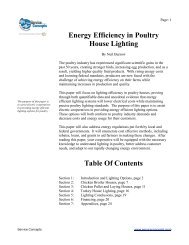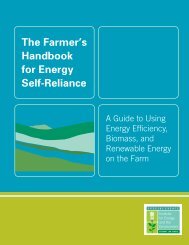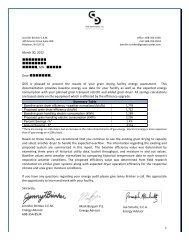Dairy Farm Energy Management Handbook - Wisconsin Department ...
Dairy Farm Energy Management Handbook - Wisconsin Department ...
Dairy Farm Energy Management Handbook - Wisconsin Department ...
Create successful ePaper yourself
Turn your PDF publications into a flip-book with our unique Google optimized e-Paper software.
Equipment Operation and Maintenance<br />
Lighting Efficiently<br />
As was mentioned earlier, lighting can account<br />
from 15% up to about 24% of electricity costs on<br />
a dairy farm. Learning how to use lighting<br />
effectively and efficiently not only can help trim<br />
your utility costs, but it can also improve working<br />
conditions and cow comfort.<br />
In a dairy, you are basically looking at three<br />
major characteristics in lighting-system<br />
performance:<br />
Recommended Illumination Levels for <strong>Dairy</strong><br />
Facility Chart<br />
• Light intensity or illumination level:<br />
Illumination levels are measured with a<br />
light meter and expressed in foot-candles<br />
(fc).<br />
In a free-stall, for example, a typical and<br />
recommended illumination level would be<br />
an average of 15 fc, while a holding area<br />
can usually get by with 10 fc. As<br />
Working conditions and cow comfort,<br />
as well as conserving energy, are<br />
greatly improved when lighting fixtures<br />
are used effectively and efficiently. --<br />
Photo Karl Ohm<br />
reference, a well-lit office usually has a light intensity of 35 to 50 foot<br />
candles.<br />
To help enhance a light’s illumination, especially in outdoor yard lights,<br />
Sanford recommends retrofitting the light with a simple, snap-on full<br />
reflector that replaces the standard refractor.<br />
A refractor, which is a prism-type glass, only directs about 30% of the<br />
full lighting to where it’s really needed.<br />
Color characteristics: Just like sunlight with its various wavelengths that<br />
produce the different colors of a rainbow, artificial lights also produce their<br />
own distinct color spectrum that influence how well objects can be perceived<br />
by the human eye.<br />
A commonly used rating is the Color Rendition Index (CRI), which ranges<br />
from 0 to 100 and indicates the light’s ability to render the true color of an<br />
object. Lights with higher CRI values produce light that renders a truer color,<br />
while lower CRI values produce some color distortion.














